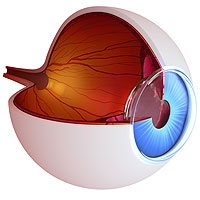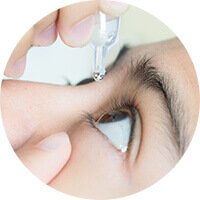What is the Cornea?
The cornea is the clear, dome-shaped tissue on the surface of the eye. The cornea may seem to lack substance, but it is actually a highly organized and complex tissue. The cornea lacks blood vessels, and therefore gets its nutrients from fluid in the eye (aqueous humor.)
The main purpose of the cornea is to protect the eye from injury and infection, as well as focus light onto the retina. Irregularities in the cornea are the cause of common refractive errors such as myopia, hyperopia and astigmatism. The cornea is made up of five main layers, each with its own job.
- Epithelium: the outermost layer of the cornea, the epithelium is responsible for protecting the eye from infection and providing a smooth surface for the tear film. This layer is very thin, and is constantly regenerating.
- Bowman’s layer: this extremely thin, strong layer acts as a sheet of connective tissue between the epithelium and stroma. Its dense nature protects the rest of the cornea from scratches and minor injury.
- Stroma: this layer makes up the majority of the cornea’s thickness. It is made of strands of connective tissue called collagen fibrils.
- Descemet’s membrane: This thin layer separates the stroma from the endothelial layer. This layer gradually thickens throughout life.
- Endothelium: This is the innermost layer of the cornea. The endothelium maintains the fluid content of the cornea. When the endothelium is not working properly, fluid can build up in the cornea and cause swelling.
Common Corneal Conditions
The cornea is surprisingly resilient, but is still susceptible to many different conditions. Common corneal conditions include:
Corneal abrasion. Corneal abrasions refer to scratches on the surface of the eye. Small scratches that only penetrate the epithelium will usually heal without any damage to vision. If the scratch penetrates beyond the Bowman’s layer, scarring can occur, which can impact vision.
Fuchs Endothelial Corneal Dystrophy. Fuchs Endothelial Corneal Dystrophy is dysfunction of the corneal endothelium. This leads to thickening of the overlying Descemet’s membrane as well as swelling of the cornea causing a decrease in the visual acuity and quality.
Bullous Keratopathy. Bullous Keratopathy is a dysfunction of the corneal endothelium caused by previous injury or surgery. This leads to swelling of the cornea causing a decrease in the visual acuity and quality. The corneal swelling can sometimes become severe and cause blisters on the epithelium which can be painful and increase risk for infection.
Keratoconus. Keratoconus is a progressive corneal dystrophy. In patients with keratoconus, the cornea begins to take on a cone-like shape and bulges forward. This causes extremely blurry vision and gets worse over time.
Dry eyes. Dry eye syndrome is one of the most common conditions in the US. Dry eye syndrome causes red, irritated, itchy and dry feeling eyes. This is commonly due to a decrease in tear production or blepharitis / meibomian gland dysfunction, which causes poor tear quality.
Corneal Procedures Available in Pennsylvania
Here at Eye Care Specialists, we take pride in offering the best corneal procedures available. These procedures include:
- DALK. Deep anterior lamellar keratoplasty (DALK) is a newer type of corneal transplant. During this procedure, the anterior (outer) portion of the cornea is replaced with donor tissue, leaving the inner layers (the endothelium) alone. Because the inner layer is retained, there is less risk of rejection.
- DMEK. Descemet membrane endothelial keratoplasty (DMEK) is a type of partial-thickness corneal transplant. During this procedure, the Descemet’s membrane and endothelium are removed and replaced with thin donor tissue consisting of only Descemet’s and endothelium. This is a delicate procedure, but ensures faster recovery time and less risk of graft rejection compared to a penetrating keratoplasty.
- DSEK. Descemets stripping endothelial keratoplasty (DSEK) is a type of partial-thickness corneal transplant. During this procedure, Descemet’s membrane and endothelium are removed and replaced with donor tissue consisting of a small amount of corneal stroma, Descemet’s membrane and endothelium. This ensures faster recovery time and less risk of graft rejection compared to a penetrating keratoplasty.
- PK. Penetrating keratoplasty (PK) is the traditional full-thickness corneal transplant. Often performed on patients with keratoconus, this procedure is usually a last resort. While this procedure is performed often and is considered safe and effective, recovery time can be long. There is also greater risk of tissue rejection than with other corneal transplants.
Are you searching for the right corneal surgeon to fit your needs? Look no further than the experts in Kingston, Hazleton, and Berwick Pennsylvania. Being one of the only practices in Pennsylvania offering these vision-saving corneal procedures, you can rest assured you are in good hands with Eye Care Specialists. Contact us today to schedule your consultation.

















